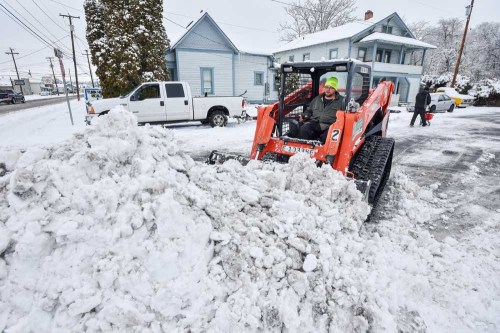Old Farmer’s Almanac predicts another snow-filled winter for Eastern Oregon
Published 5:00 am Thursday, September 5, 2019

- Top: Travis Hamman uses a bobcat to move snow while working with NW Installations snow removal service in Pendleton in February 2019. Above: Pedestrians and vehicles navigate snow-covered roads on Dec. 28, 2017, in downtown Pendleton. According to the Old Farmer’s Almanac’s 2020 edition released last week, Eastern Oregon should expect colder temperatures with above average precipitation and snowfall this winter.
PENDLETON — It might be time to check that those winter jackets and boots are still in the back of your closet where you left them in the spring.
Or so says the Old Farmer’s Almanac, at least.
According to the reference book’s 2020 edition released last week, Eastern Oregon should expect colder temperatures with above average precipitation and snowfall this winter.
The almanac positions Eastern Oregon in the Intermountain region, which stretches as far south as Flagstaff, Arizona, and as far north as the U.S.-Canada border. In total, the region encompasses nine different states between the Cascade and Rocky Mountains.
For the 2019-20 winter, the Intermountain region will reportedly be characterized by “low temps, deep powder.” Across the country, the almanac is predicting “frequent snow events — from flurries to no fewer than seven big snowstorms from coast to coast.”
In February, Pendleton recorded all-time highs in snowfall after being covered in 32.5 inches during the shortest month of the year. That’s nearly double the previous record of 16.8 inches and, according to the National Weather Service, nearly 10 times the average snowfall of 3.4 inches for the month.
While the area saw some more snowfall in March this year, the Old Farmer’s Almanac warns that Eastern Oregon and the rest of the Intermountain region should expect two big snowstorms as late as April next year.
Per NWS data, the most recorded snowfall in Pendleton during April was 2.2 inches in 1975.
Another snow- and rain-heavy winter would continue a streak for the city. From the start of December 2018 through March of this year, NWS data shows Pendleton received 36.3 inches of snow and 7.7 inches of rain. That data also shows the city’s winter average as 13.7 inches and 5.29 inches, respectively.
If the Old Farmer’s Almanac is right, it’d be a winter trend not expected to last.
The Wallowa County Chieftain reported last week that a University of Idaho study found that “consecutive low snow years may become six times more common across the Western United States over the latter half of this century.”
The question is, will the Old Farmer’s Almanac be right?
Founded in 1792 by Robert B. Thomas, the Old Farmer’s Almanac provides information on weather forecasts, planting cycles, astronomical data, recipes and more. Using a secret formula derived from weather patterns, astronomical cycles, and sun spots, the almanac has published long-term winter forecasts for over two centuries.
Though these long range predictions are made up to 18 months in advance, the publication has long boasted an accuracy rate of 80% or above.
George Perry, general forecaster at the NWS’s Pendleton office, said he doesn’t pay much attention to the almanac’s predictions and can’t say anything about its accuracy without knowing its method.
However, when it comes to the forecasts the NWS develops for weather 7-14 days in advance — the NWS’s Climate Prediction Center produces forecasts as much as three months out — Perry said they use models to analyze and make predictions.
But still, forecasts one to two weeks ahead of time are “highly variable.”
“You can get small changes in two days that may not do much at the time but could influence significant changes in 10 days,” Perry said.





